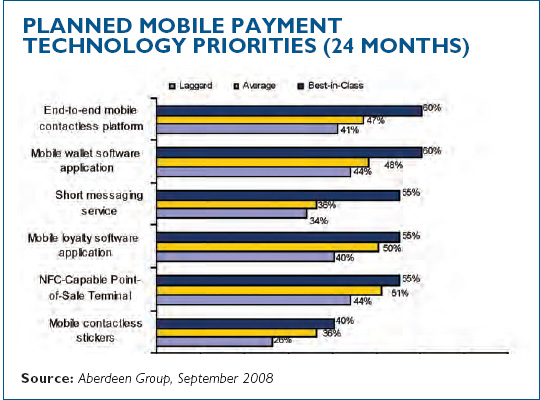
According to Gartner, the number of people making mobile payments globally is set to increase from 32.9 million in 2008 to 103.9 million in 2011, while Juniper Research estimates around 52 million consumers will adopt new mobile technologies to pay for everyday goods and services by 2011. So where is this booming new market going? Heather McLean investigates…
Juniper says the mobile payments industry as a whole is tipped to be worth $22 billion by 2011. By 2013 near field communication (NFC) payments will be worth $75 billion, it states. Juniper’s research show that the global annual gross mobile transaction value will grow over five times by 2013.
The majority of mobile payments today are completed via Premium SMS. This uses the messaging interface of text to execute a billing transaction. Andrew Bud, executive chairman at mBlox, comments: “This is a slightly odd and imperfect approach which has nevertheless been very successful, enabling a market worth about $25 billion worldwide. In a growing number of countries, ordinary SMS text is used as the means to control a payment transaction completed through a bank. In such cases, the key technologies are the SIM card, its security features and those associated encryption and security systems in the mobile networks.
“In future, we will see NFC as a means of activating transactions, and highly secure SIM modules to provide a much more robust level of identity authentication,” states Bud.
Enabling mobile wallets
NFC enables a system, such as a railway entry barrier or an advertising poster, to communicate over a very short distance with an NFC-enabled device, such as a phone. The key to NFC is that while it is a powerful and secure way of exchanging digital information, it is also incredibly simple to use. This simplicity is the revolutionary key to success, as technologies like Bluetooth and even SMS commerce have proven to be too cumbersome for most retail applications.
Bud comments: “With NFC, a simple tap on a panel is all that is required. Yet because that tap enables a complex digital exchange, it can enact payments, cash transfers, ticketing, or even internet redirects. Combine that with the network access and the user interface of a mobile phone and there is a really powerful tool for acquiring and using all sorts of tokens of value.”
The beauty of NFC is in its simplicity and ease of use, states David Wollen, CEO at Innovision Research & Technology. “For retailers and other merchants, NFC-enabled payments are much easier and cheaper to handle than cash or other traditional payment methods. For consumers, it’s a one stop shop for payments, whether they have a credit or debit card, or a travel ticket loaded onto their handset. Using a mobile handset to pay with a touch is ideal for rapid turnaround payment environments such as fast food restaurants, vending machines, parking meters and newspaper kiosks.”
O2’s trial a success
There are many trials and pilots already in place using NFC technology for payments. At the end of last year, about 20,000 of Innovision’s Topaz tags, one of the smallest and lowest cost NFC tags available, were used as part of O2’s first ever NFC consumer trial in London.
O2’s wallet trial ran over six months to May 2008. The trial tested consumer demand for having cards you would normally carry in a wallet, such as Oyster and credit cards, available on a Nokia 6131 NFC mobile phone. Participants were able to use their mobile to travel on London’s transport system or to make a payment in a retail store, simply by touching their phone against a reader. The trial involved O2, Transport for London, Barclaycard, Visa Europe, TranSys, Nokia and AEG.
O2 claims nine out of ten participants were happy using NFC technology on a mobile phone, and 78% said they would be interested in using contactless services if available. Convenience, ease of use and the status of having such an innovative device were seen as the main benefits. Key findings around the Oyster facility on mobile included that 67% said that it was more convenient to use than a standard Oyster card and 87% said that availability of the service would be likely to influence their purchase of a new mobile phone.
Howard Wilcox, senior analyst at Juniper Research, comments on where this trial is taking the industry: “NFC-enabled phones will use the same technology that is used in Oyster cards in London, enabling users to wave their device close to an NFC reader and pay for goods and services. NFC will therefore be very convenient for users for smaller value purchases, but it will also enable a range of other services and features including access control to buildings and events, smart posters and ticketing. The phone will evolve into a mobile wallet, carrying credit cards.”
More recently, NFC wristband technology was trailed at the O2 Wireless Festival in July. The tagged wristbands, enabled by Innovision’s Topaz tags, were given away to festival-goers who used them to get exclusive access to the O2 bus. They could also receive a free cocktail by scanning their wristband at an NFC terminal and gain entry to exclusive VIP facilities.
Global advancement
| Howard Wilcox, senior analyst at Juniper Research |
 |
| Stephen Gibb, chief information officer at Upaid, |
 |
“Just as acceptance is a barrier for merchants’ take up of mobile phone payments, consumers are also concerned about pay-by-phone. The more immediate concern for the public is around security. Beyond the technology being in place, consumers should remember that fraudsters are less interested in perpetrating crime with mobile payments because today’s transactions are of low value and are not widespread. The risk of fraud is not high and should therefore not be a barrier for adoption.
Wilcox agrees that retailers and consumers are the main issues here: “For example, for NFC payments to take off, retailers will need to install NFC card readers at their POS. For users, the main issue revolves around security and trust, and answering the question ‘Why do I need another way to pay after cash, debit and credit card?’.”
Exciting times
However, it is a really exciting time for the mobile payments space, comments Maslen. She says both brands and retailers are recognising that mobile solutions can bring cost savings and convenience: “We are already seeing the take up of mobile ticketing, barcodes and coupons. Once the initial hurdles are overcome and NFC-enabled payment systems become commonplace, the potential for mobile payments is vast.”
Bud comments: “We believe that the next phase in the growth of mobile payments for digital goods will be set off by the wide availability of sender-pays data. The ability to deliver rich media files to a consumer’s handset without any risk of data bill shock will be crucial to the development of the video and music content business on mobile. Trials are starting now, and we are confident this is the way the industry will go. Another major driver is the use of mobile payment to charge for online digital content. Looking further ahead, there is no doubt that ticketing, especially when enabled by NFC technologies, will be a major driver for mobile payments.”
Continuing, Bud says: “In developed countries, the industry in the near term will focus on competing for the most compelling contactless card payments solutions as well as mobile banking solutions. In contrast, contactless mobile payments will take a much longer time to evolve as they will require collaboration between banks and telecom operators.
“The obvious step forward is for banks and networks to cooperate,” he adds. “Each has something the other can’t provide. Banks can manage the payment risk while the networks have the handset, the secure SIM and user interface. Through this collaboration, mobile payments can really be driven forward and taken to the next level, with greater sophistication in mobile payments systems.”

Giong mass market
Stephen Gibb, chief information officer at Upaid, agrees: “We think that for mobile payments to become a valuable payment method it has to be in a mass market and, to get a mass market, banks and operators need to work together, neither party independent of the other. Only then will mobile payments become a healthy alternative to cash and other mainstream payment applications.”
Yet Gibb continues, stating this cohesion between operator and banks is currently lacking in Western Europe: “If you look at the European market, most operators remain locked in a debate over who, the banks or operators, should own the customer. This obsession so dominates the thinking of the region’s mobile operators that some of them have sought to limit deals with banks to no more than a single partner. But to take advantage of these new technologies, operators need to overcome their irrational fear of losing ownership of their customers.”
Wollen comments on the future: “One key to the success of mobile payments is the availability of NFC functionality in mobile handsets. And this will only happen for the mass market by integrating NFC technology into existing chip technology, rather than using standalone NFC chipsets. This will significantly bring down the cost of highvolume production, making NFC-enabled mobile devices more attractive to mobile phone manufacturers and to users. This provides the basic technical capability to support mobile payments.”
The mobile payments market is going to expand dramatically, says Gibb: “The future of mobile payments is an interesting one. The real opportunity for mobile payments to take off will be in remote transactions. However, for payments at the point of sale, it remains to be seen whether customers will fully embrace mobile NFC technology as a secure payment method and replace the bank card in their pocket with an NFC enabled phone.”
Denton states the future for mobile payments depends on the cooperation of network operators: “Most operators have little role and hence little ability to make money in NFC. The transactions pass them by and so they cannot make money by handling them in the middle. This leaves them with managing the device and its security, together with the application delivery. Whilst this can and will generate a revenue stream it is not a high value repeat revenue stream. So will the operators be interested? This remains to be seen.”


